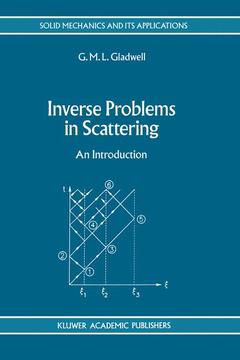Inverse Problems in Scattering, Softcover reprint of the original 1st ed. 1993 An Introduction Solid Mechanics and Its Applications Series, Vol. 23
Langue : Anglais
Auteur : Gladwell G.M.L.

Inverse Problems in Scattering exposes some of the mathematics which has been developed in attempts to solve the one-dimensional inverse scattering problem. Layered media are treated in Chapters 1--6 and quantum mechanical models in Chapters 7--10. Thus, Chapters 2 and 6 show the connections between matrix theory, Schur's lemma in complex analysis, the Levinson--Durbin algorithm, filter theory, moment problems and orthogonal polynomials. The chapters devoted to the simplest inverse scattering problems in quantum mechanics show how the Gel'fand--Levitan and Marchenko equations arose. The introduction to this problem is an excursion through the inverse problem related to a finite difference version of Schrödinger's equation. One of the basic problems in inverse quantum scattering is to determine what conditions must be imposed on the scattering data to ensure that they correspond to a regular potential, which involves Lebesque integrable functions, which are introduced in Chapter 9.
1 Some Simple Wave Phenomena.- 1.1 Waves.- 1.2 Generalized Functions.- 1.3 Lossless Transmission Lines.- 1.4 Waves in an Elastic Medium.- 1.5 Sound Waves.- 1.6 Reflection and Transmission of Waves.- 1.7 Standardising the Wave Equations.- 1.8 Standardised Reflection and Transmission.- 1.9 Conservation Equations.- 1.10 Difference Schemes for Wave Problems.- 1.11 Down-Up Difference Schemes.- 1.12 Causal Solutions, Green’s Functions and z-Transforms.- 2 Layer-Peeling Methods for Discrete Inverse Problems.- 2.1 Introduction.- 2.2 On the Interpretation of the Discrete Equations.- 2.3 The Impulse Response and the Propagation of the Wavefront.- 2.4 Discrete Equations for Layer-Peeling Methods.- 2.5 Some Questions.- 2.6 Functions of a Complex Variable.- 2.7 Schur’s Lemma.- 2.8 The Schur Algorithm and Downward Continuation.- 2.9 The Schur Algorithm and Toeplitz Matrices.- 2.10 Layered Media of Non-Goupillaud Type.- 3 The Inversion of Discrete Systems Using Non-Causal Solutions.- 3.1 Introduction.- 3.2 Some Simple Non-Causal Solutions.- 3.3 Claerbout’s Equation.- 3.4 Levinson’s Algorithm.- 3.5 Levinson’s Algorithm and Claerbout’s Equation.- 3.6 A Discrete Gel’fand-Levitan Equation.- 3.7 Bruckstein and Kailath’s Equation.- 3.8 Time-Sums of the Basic Solutions.- 3.9 A Discrete Gopinath-Sondhi Equation.- 3.10 Comments on the Literature.- 4 Waves in Non-Uniform Media.- 4.1 Introduction.- 4.2 Characteristics.- 4.3 Causality, Initial Value Problems and Intervals of Dependence.- 4.4 Riemann’s Representation.- 4.5 Difference Schemes for Initial-Value Problems.- 4.6 Initial-Value-Boundary-Value Problems.- 4.7 The Propagation of Singularities.- 5 The Inversion of Continuous Systems Using Causal Solutions.- 5.1 Introduction.- 5.2 Reconstruction of the Impedance.- 5.3Reconstruction of the Reflection Function.- 5.4 A Non-Linear Integral Equation for the Reflection Function.- 6 Inversion of Continuous Systems Using Non-Causal Solutions.- 6.1 Introduction.- 6.2 The Basic Solutions.- 6.3 Some General Integral Equations.- 6.4 Krein’s Integral Equation.- 6.5 The Levinson-Durbin Algorithm.- 6.6 The Linear Gel’fand Levitan Integral Equation.- 6.7 The Non-Linear Gel’fand-Levitan Equation.- 6.8 The Marchenko Integral Equation.- 6.9 The Gopinath-Sondhi Equation.- 7 An Introduction to the Inverse Scattering Problem of Quantum Theory.- 7.1 Introduction.- 7.2 Schrödinger’s Equation.- 7.3 Orthogonal Polynomials.- 7.4 The Spectral Problem for a Jacobi Matrix.- 7.5 Functions of a Complex Variable—II.- 7.6 Fourier’s Problem.- 7.7 A Finite-Difference Form of the Schrödinger Equation.- 7.8 A Finite-Difference Form of the R-Matrix Approach.- 7.9 The Determination of the Jost Function.- 7.10 The Gel’fand Levitan Procedure for Jacobi Matrices.- 7.11 The Gel’fand-Levitan Procedure.- 7.12 The Marchenko Procedure.- 7.13 Some Generalizations.- 8 The Schrödinger Equation on the Half Line.- 8.1 Introduction.- 8.2 The Schrödinger Equation on the Finite Line.- 8.3 The Spectrum for the Finite Line is Discrete.- 8.4 Schrödinger’s Equation on the Half Line: The Discrete Spectrum.- 8.5 The Regular Solution.- 8.6 The Jost Solution.- 8.7 The Jost Function and the Phase Shift.- 8.8 The Bound States.- 8.9 The Integral Representation of the Jost Function.- 8.10 The Orthogonality Relations.- 9 The Lebesque Integral.- 9.1 Introduction.- 9.2 Real and Complex Numbers.- 9.3 Metric Spaces.- 9.4 Functions and Function Spaces.- 9.5 The Riemann Integral.- 9.6 Measurable Sets and Measurable Functions.- 9.7 The Lebesgue Integral.- 9.8 Applications andProperties of the Lebesgue Integral.- 9.9 Differentiation and Integration.- 9.10 Fourier Transforms.- 10 Inverse Scattering for the Schrödinger Equation.- 10.1 Introduction.- 10.2 The Pozner-Levitan Representation of ?.- 10.3 The Gel’fand-Levitan Integral Equation.- 10.4 The Levin Representation of the Jost Solution.- 10.5 The Marchenko Integral Equation.- 10.6 Equivalence of the Equations of Gel’fand-Levitan and Marchenko.- 10.7 Conditions on the Data Leading to a Regular Potential.- References.- Index of Notations.
Date de parution : 10-2012
Ouvrage de 366 p.
15.5x23.5 cm
© 2024 LAVOISIER S.A.S.



